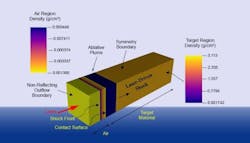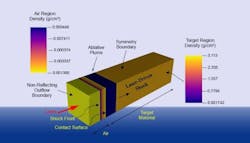Ultrashort-pulse laser method could improve industrial laser processing
By using ultrashort laser pulses, a team of researchers at the Lawrence Livermore National Laboratory (LLNL; Livermore, CA) has found an efficient mechanism for laser ablation that could help pave the way to the use of lower-energy, less costly lasers in many industrial laser processing applications.
The method uses short-wavelength, high-fluence (energy per unit area) laser pulses to drive shockwaves that melt the target material. After the passage of the shockwave, the melt layer is placed under tension during a process known as relaxation, ultimately leading to the ejection of material through cavitation (unstable bubble growth).
The researchers used a combination of experiments and enhanced computer simulations in a range of laser energies and wavelengths to study ultrashort-pulse laser ablation of aluminum, stainless steel, and silicon. Their findings show that ultraviolet (UV) picosecond pulses at fluences above 10 J/cm2 can remove more material with less energy than longer-wavelength pulses.
"We discovered that this range above 10 joules per square centimeter, particularly for UV laser pulses, was behaving very differently than lower fluences and longer wavelengths," says Jeff Bude, NIF & Photon Science deputy principal associate director for Science & Technology at LLNL.
"The removal rate jumps when you go beyond 10 joules per square centimeter, and especially for the UV light," Bude explains. "At the same time, the jump in the removal is accompanied by an increase in the removal efficiency—a reduction in the amount of energy required to remove a given volume of material."
The researchers compared the results from laser wavelengths of 355 nm (UV) and 1064 nm (near-infrared) over a fluence range of 0.1 to 40 J/cm2 and found that the shorter wavelengths enhanced removal by nearly an order of magnitude over the measured removal at 1064 nm. Laser ablation was many times more efficient at the UV wavelength compared to the near-infrared in all three materials.
Simulations using the radiation hydrodynamic code HYDRA showed that the increase in ablation efficiency was due to the UV laser pulses penetrating deeper into the ablative plume and depositing energy closer to the target surface, which resulted in higher-pressure shocks, deeper melt penetration, and more extensive removal due to cavitation.
An illustration of the model used in the picosecond-pulse laser ablation studies:The model was developed in the multiphysics radiation hydrodynamic code HYDRA; the illustration shows a 1D version of the model along the central axis of the laser beam, which was utilized to study material response in isolation from 3D geometric effects.
"The removal mechanism—shock heating creating a melt and then removing that with cavitation—requires less energy to remove material than vaporization of the material," Bude says. "That's the explanation for why it's more efficient."
"This was a particularly challenging problem to model because the laser energy deposition process was closely coupled with the material hydrodynamic response, requiring a unique code like HYDRA that has this integrated capability," explains LLNL analyst Wes Keller, the lead author of the paper that describes the work.
Shortly after the study began, the researchers realized that material response to picosecond lasers was a good deal more complicated than if the more-common femtosecond lasers had been used.
"When you're trying to understand picosecond laser processing, some of the simplifying assumptions of the physics that you get with very short (femtosecond) pulses are no longer reliable," Bude says. Rather than simply absorbing the laser energy and vaporizing, "the material was moving, it was evolving in the laser plume," he says. This meant that the models had to be tweaked to account for both the hydrodynamics of the melting material and the interactions between the laser pulse and the plasma (ionized gas) in the ablative plume.
To model laser-plasma interaction correctly, the research team had to do a lot of creative experiments to fix some inadequacies in the model, Bude explains. By identifying the essential physics of this regime, the team discovered that shock heating is necessary to create micron-deep melt. Then, after creating this deep melt with shock heating, the team found that the mechanism to remove it was cavitation, he says.
Once they realized that temporally shaped, or timed, pulses could exploit the instabilities in the melted material, the researchers were able to use shaped pulses to create a more efficient way to remove material.
The results also suggest that picosecond-pulse lasers offer several advantages over the more commonly used femtosecond lasers in terms of cost, efficiency and damage control. In addition, they offer options for efficient frequency conversion for wavelength flexibility.
Full details of the work appear in the Journal of Applied Physics.

